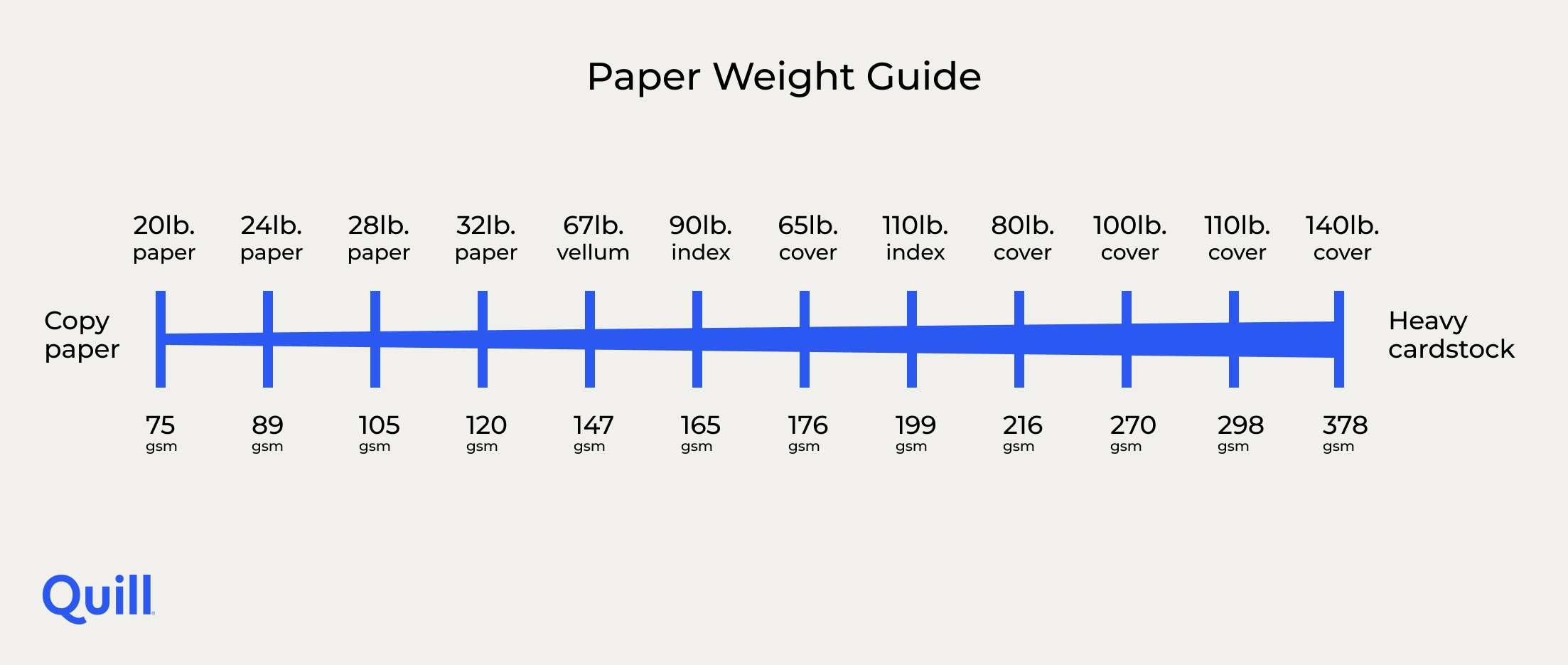Paper comes in a variety of weights, sizes, and textures that enable all manner of office and creative print jobs. While variety is what makes paper so functional and versatile, it's also part of what makes paper so misunderstood. Let's clear up a few things about the definitions and potential uses of different paper weights so you get exactly what you need every time.
How is Paper Weight Measured? Pounds vs GSM (Grams per Square Meter)
Let's look at the three ways paper weight can be measured.
U.S. basis weight of paper
Unit: Pounds
How it's measured: The weight of 500 sheets of paper in its uncut form. For example, an uncut sheet of bond paper is 17 x 22 inches before it's cut to letter size and 500 sheets of it weigh 20 pounds - this makes the paper "20 lb" bond paper.
Other considerations: As you can imagine, these measurements can be difficult to understand for several reasons. First, higher values don't necessarily correspond to heavier paper. Second, there is no standard size for the uncut paper, which can make it hard to compare different weights. Third, two papers may share the same basis weight but have markedly different characteristics. Because of the potential for confusion, most reams of paper list a metric measurement along with the U.S. basis weight.
Metric weight of paper
Unit: Grams
How it's measured: The weight of a sheet of paper cut to a 1 x 1 meter square
Other considerations: This is also known as "grammage" or GSM. Because the size of the weighed paper is always the same, the metric weight of paper provides the most clear-cut comparison between different paper weights.
Points or mils
Unit: Both of these terms refer to 1/1000 of an inch.
How it's measured: Using a caliper to weigh the exact thickness of a given piece of paper
Other considerations: This is arguably the simplest way to measure paper weight. The thicker the paper, the higher the paper weight.
We know this is a lot to remember. That's why we've made some resources to help you compare paper weights and decide which paper is best for your project.

The Many Uses of Different Paper Weights
| Type of paper | Available weights | Common uses |
|---|---|---|
| Bond paper | 16, 20, 24, 28, 32, and 36 pounds |
|
| Book paper | 30 to 115 pounds | Print books, booklets, catalogs, magazine publications, and posters |
| Cover paper | 60 to 120 pounds | Business cards, door hangers, menus, invitations, postcards, rack cards, report covers, self-mailers, and sketching |
| Index paper | 90, 110, and 140 pounds | Index cards, postcards, tabs and dividers, manila folders, and sketchbooks |
| Tag paper | 50, 60, 70, 80, and 100 pounds | Retail signage, price tags, table tents, file folders, door hangers, direct mail postcards, menus, posters, and time cards |
| Text paper | 50, 60, 70, 80, and 100 pounds | Commercial printing operations for brochures, letterhead print jobs, stationery, internal memos, and thesis papers |
Most Americans will be most familiar with paper weight measured in pounds. These include bond, book, cover, index, tag, and text. Each of these types can encompass a variety of weights and has specific uses they're best suited for. Here's a basic overview.
- Bond paper (16, 20, 24, 28, 32, and 36 pounds): Also known as writing paper, this is the paper weight for printer paper and copier paper. In addition to everyday printing, it's most commonly used for letterhead and stationery. Lighter-weight bond paper is ideal for faxes, printing emails, tracing, and use in high-speed copiers. Mid-weight bond paper is highly versatile and works well for reports, business letterhead paper, double-sided printing, legal documents, and proposals. Heavier-weight bond paper also works well for double-sided printing and presentations as well as signs, fliers, contracts, and resume paper.
- Book paper (30 to 115 pounds): This category includes coated and uncoated papers of varying thicknesses. Book paper is commonly used to print books, of course, but also booklets, catalogs, magazine publications, and posters.
- Cover paper (60 to 120 pounds): Commonly referred to as cardstock, cover paper is thick and stiff (although as you can see by the pound range, this thickness can vary substantially). It is frequently used for business cards, door hangers, menus, invitations, postcards, rack cards, report covers, self-mailers, sketching, and so on.
- Index paper (90, 110, and 140 pounds): As the name suggests, this stiff paper is most commonly used for index cards. It's also frequently used for postcards, tabs and dividers, manila folders, and sketchbooks.
- Tag paper (100 to 200 pounds): Highly durable and stiff, tag paper is used for retail signage, price tags, table tents, file folders, door hangers, direct mail postcards, menus, posters, and timecards.
- Text paper (50, 60, 70, 80, and 100 pounds): : This type of paper is usually an upgrade in quality over book paper and is most commonly used in commercial printing operations. Uses for text paper may include brochures, letterhead print jobs, stationery, internal memos, and thesis papers.
There are many factors to consider when choosing the right paper for your project. We hope you come back to our guide again and again to help you get just what you need every time.




